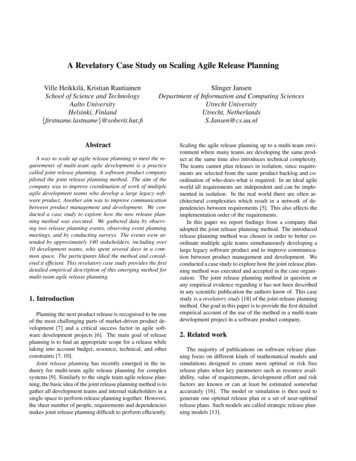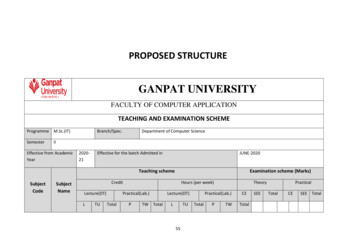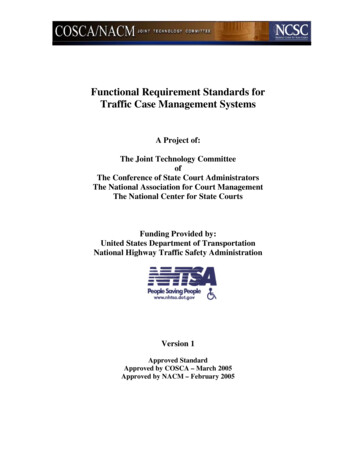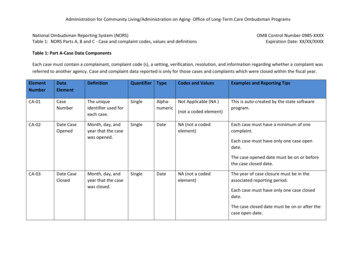
Transcription
A Revelatory Case Study on Scaling Agile Release PlanningVille Heikkilä, Kristian RautiainenSchool of Science and TechnologyAalto UniversityHelsinki, Finland{firstname.lastname}@soberit.hut.fiSlinger JansenDepartment of Information and Computing SciencesUtrecht UniversityUtrecht, NetherlandsS.Jansen@cs.uu.nlAbstractA way to scale up agile release planning to meet the requirements of multi-team agile development is a practicecalled joint release planning. A software product companypiloted the joint release planning method. The aim of thecompany was to improve coordination of work of multipleagile development teams who develop a large legacy software product. Another aim was to improve communicationbetween product management and development. We conducted a case study to explore how the new release planning method was executed. We gathered data by observing two release planning events, observing event planningmeetings, and by conducting surveys. The events were attended by approximately 140 stakeholders, including over10 development teams, who spent several days in a common space. The participants liked the method and considered it efficient. This revelatory case study provides the firstdetailed empirical description of this emerging method formulti-team agile release planning.1. IntroductionPlanning the next product release is recognised to be oneof the most challenging parts of market-driven product development [7] and a critical success factor in agile software development projects [6]. The main goal of releaseplanning is to find an appropriate scope for a release whiletaking into account budget, resource, technical, and otherconstraints [7, 10].Joint release planning has recently emerged in the industry for multi-team agile release planning for complexsystems [9]. Similarly to the single team agile release planning, the basic idea of the joint release planning method is togather all development teams and internal stakeholders in asingle space to perform release planning together. However,the sheer number of people, requirements and dependenciesmakes joint release planning difficult to perform efficiently.Scaling the agile release planning up to a multi-team environment where many teams are developing the same product at the same time also introduces technical complexity.The teams cannot plan releases in isolation, since requirements are selected from the same product backlog and coordination of who-does-what is required. In an ideal agileworld all requirements are independent and can be implemented in isolation. In the real world there are often architectural complexities which result in a network of dependencies between requirements [5]. This also affects theimplementation order of the requirements.In this paper we report findings from a company thatadopted the joint release planning method. The introducedrelease planning method was chosen in order to better coordinate multiple agile teams simultaneously developing alarge legacy software product and to improve communication between product management and development. Weconducted a case study to explore how the joint release planning method was executed and accepted in the case organization. The joint release planning method in question orany empirical evidence regarding it has not been describedin any scientific publication the authors know of. This casestudy is a revelatory study [18] of the joint release planningmethod. Our goal in this paper is to provide the first detailedempirical account of the use of the method in a multi-teamdevelopment project in a software product company.2. Related workThe majority of publications on software release planning focus on different kinds of mathematical models andsimulations designed to create most optimal or risk freerelease plans when key parameters such as resource availability, value of requirements, development effort and riskfactors are known or can at least be estimated somewhataccurately [16]. The model or simulation is then used togenerate one optimal release plan or a set of near-optimalrelease plans. Such models are called strategic release planning models [13].
The validity of most of the strategic release planningmodels in large scale industrial setting is questionable.Svahnberg et al. [16] reviewed 22 strategic release planning models. Only four of those models had been validatedin large scale industrial use. In addition, the model-drivenapproach to release planning has proven to be problematic in practice, as many software companies do not havea software development process which could be relied onto record or generate required key parameters [4] and oftenrequirements change so frequently that any long term planquickly becomes obsolete [2]. Agile software developmentmethods claim to mitigate these issues by not creating detailed long term plans and by adapting to changing requirements and priorities when needed [1].Release planning in the agile software development context has only been slightly addressed in scientific literature.The little existing literature applies the plan-driven releaseplanning approach in agile software development context,and usually without taking into account that following ahighly detailed release plan is not considered necessary oreven useful in agile software development (see e.g. [3, 8]).The Scrum process model [14] defines the product ownerrole, whose responsibility is managing the development ofa product. The agile release planning process in a singleteam single-product development scenario is simple. Theteam and a product owner discuss the features that couldbe included in the next release until an agreeable plan isreached. The agreed-upon release plan then acts as a visionfor planning the individual iterations [14, 15, 12].3. Research methodologyRelease planning of a new version of a product that belongs to an existing product line was studied in this longitudinal case study [18]. Two successive joint release planning events of the next product release were observed. Thefirst event was an initial joint release planning event (calledEvent A hereafter) and the second was a release re-planningevent conducted eight weeks later (called Event B hereafter).3.1. Case backgroundThe agile software development process in the case company is based on Scrum [14]. Except for the parts that aredirectly related to describing the release planning events,a more precise description of the case company’s development and product management model is out of the scope ofthis paper. Also, a broader description of the case companyis omitted for confidentiality reasons.In the case company’s release management model, requirements management is based on a five-level hierarchyintroduced by Leffingwell [9]. Strategic themes denotestrategic focus areas for the company’s business. Withinthese, epics form high-level functional goals for the product(s). Epics can be split into features, which in turn canbe further split into user stories. Finally, user stories arerefined into development tasks, which denote what needs tobe done technically to implement a user story.The plans for a release project can be seen on two timehorizons. Roadmaps, which contain epics and features,show the tentative content of future releases. The next upcoming release can be split into potentially shippable increments (PSIs), which are internal releases of the product containing a subset of the intended features of the final, externalrelease of the product. The joint release planning concentrates on planning the next PSI of a product release. Thework during a PSI is done in iterations, which are plannedwith detailed tasks. Together these levels of planning forma rhythm for product development (aka cadence). This wayof planning follows the principle of planning long term withabstract requirements and short term with detailed requirements [11, 17].The release project in the case company was planned tolast for approximately six months and contain two PSIs.The first PSI was planned to contain seven two-week iterations. The main purpose of the first joint release planningevent (Event A) was the planning of the next PSI. Since thejoint release planning method was new to the case companyand there were major technical changes in the product architecture, a release re-planning event (Event B) was scheduledto follow the fourth (hardening) iteration. Event B was conducted as a normal joint release planning event where thescope was the rest of the PSI and planning was done takinginto account the progress of the PSI so far. Figure 1 showsthe case company’s planned release project cadence.The release project organization we studied in the casecompany consists of over 10 development teams, a user experience team, a system team, and a product managementteam including a release project manager. Each development team consists of 6-8 developers and has a scrum master and a product owner as additional members. However,all teams do not have a dedicated scrum master or productowner. The system team is a specialized group that is responsible for system level quality assurance, developmentinfrastructure and continuous improvement of developmentpractices. The product management team is responsible forthe operational management of the release project.3.2. Data collectionTwo researchers observed both release planning events.The researchers wrote separate observation notes during theevents. Two voice recorders were used to record presentations and different discussions. Also, a survey was conducted after each event. The description of the case in thispaper is based on those observations, notes, recordings, andsurvey results. After Event A the researchers compiled a
Release projectPotentially shippableincrement 1 (PSI1)Iteration 1 Iteration 2 Iteration 3PSI1 releaseplanning (Event A)HardeningiterationIteration 5 Iteration 6Potentially shippableincrement 2 (PSI2)HardeningiterationRe-planning(Event B)Iteration 8 Iteration 9.PSI2 releaseplanningIterationn-1Iteration nHardeningiterationPublicreleaseFigure 1. Case company development cadencereport for the case company. The report contained observedweaknesses in the process and improvement suggestions.The researchers also participated in a preparatory meeting for Event B, where the survey results, the report, andchanges to the planning process were discussed with releaseproject stakeholders.A survey was conducted after Event A to gather opinionson the planning method and planning success from the participants. The survey contained questionnaire statements ona six-point Likert-like scale with items “strongly disagree”(1), “disagree” (2), slightly disagree” (3), “slightly agree”(4), “agree” (5) and “strongly agree” (6). In addition, theitem “not applicable / cannot say” was provided. The survey also contained free-text fields for textual feedback, aquestion to grade the event on a scale from one to six andquestions for gathering demographic information.A second survey was conducted after Event B. It contained a subset of statements from the first questionnaire andadditional statements regarding the new practices taken intouse in Event B. All participants of the events were invited toanswer the questionnaires. The Event A survey was sent to140 participants and answered by 33 respondents, and theEvent B survey was sent to 136 participants and answeredby 26 respondents. The questionnaires were conducted withan online survey software and they were completely anonymous to increase the validity of the results.4. Results4.1. Overview of the joint release planning eventsDuring both events, most members of all developmentteams were in present. Three of the development teamswere offshored and had only three representatives presentat the release planning sessions. In addition to the development teams, a user experience team representative, thesystem team, several representatives of the product management team and several other internal stakeholders withdependencies to the product were present in the events. Thetotal number of participants was approximately 140 in bothevents.The release planning facility had a separate area forthe different stakeholder presentations and for the teams topresent their plans. Team breakout areas were separated bymovable walls which acted as planning boards and dampened noise, but also provided easy access between the different areas. In Event B an area was reserved for productmanagers, architects, and other internal stakeholders wherethey could be found when they were not with a team duringteam breakout sessions.A facilitator had an important role in the joint releaseplanning events. The facilitator was responsible for makingsure that the event was proceeding as planned and withinschedule, and solving conflicts and impediments that roseduring the events. A process consultant facilitated Event Aand the preceding training day, and acted as an advisor forthe project manager who facilitated Event B.Because the joint release planning method was previously unfamiliar to the case company, a training session wasconducted a day before Event A started. During the trainingsession the facilitator gave presentations on general principles of agile development and on how to perform the releaseplanning.The joint release planning events in the case companyfollowed the general structure presented in Figure 2. Theevents started with a presentation of the overview of theevent. In Event B it was followed by a role-specific projectretrospective. In Event A the project retrospective was notheld, since the project had not yet started. Different stakeholders then presented their visions for the product. Next,instructions on how to perform the planning were givenby the facilitator. After the presentations the developmentteams started planning the release in team breakout sessions. During Event A the breakout sessions ended in collective status presentations before lunch and at the end ofthe day. During Event B there were hourly status checks inaddition to end-of-the-day status presentations.At the end of the events, the teams’ plans were collectively reviewed and open risks were processed. As a finalstep, an event retrospective was held to improve the planning method. Each step of the event structure is describedin more detail in the following sections.The case company’s planning events span over severaldays. Event A was originally scheduled to take two dayswith one day in reserve in case the planning could not becompleted in two days. After the first actual planning daythe facilitator and the project manager came to the conclu-
StartIntroduction Project retrospective Vision presentations InstructionsTeambreakoutplanningsessionsStatus checkEndPlan review Planning retrospectiveFigure 2. A generic timeline of the joint sprint planning events (not in scale)sion that the planning needed to be extended into the thirdday. Event B was originally scheduled to take one and a halfdays with the rest of the second day in reserve. However,the project manager decided to extend Event B to take thewhole second day before the event had started.4.2. Presentations and project retrospectiveEvent A began with an introductory overview of therelease project. The topics covered were project background, product positioning in the market, target customers, overview of the competition, project organizationand project cadence. In addition an overview of the eventschedule was given. In Event B, the presentation wasshorter and contained only changes to event practices andschedule.In Event A, the introduction was followed by the first vision presentation. It was given by the head of product management. He presented the product’s vision and businessthemes and the epics for the whole release project as wellas the ones intended for PSI1. Several representatives fromdifferent specialized teams and other internal stakeholdersgave their own vision presentations: a product architecturemanager, a user experience team representative, a researchdepartment representative and a system team representative.Since the development of the new version of the productwas initiated in Event A, it also acted as a project kickoff.Handouts of each presentation and additional in-depth information on the topics were distributed to all participants.In Event B, the introduction was followed by a releaseproject retrospective. The purpose of the release projectretrospective was to find and solve impediments and learnfrom the good and bad practices observed during the releaseproject so far. The retrospective was performed in rolebased teams. The different teams were software engineers,test engineers, architects, scrum masters, and product management. Each team had a named facilitator selected fromthe team. The teams were free to conduct the retrospective as they preferred, but they were requested to produce abriefing of corrective actions to present for the other teamsand describe one or two things that went well or did not gowell since the beginning of the release project.The retrospective was followed by a presentation of therequirements for the rest of PSI1. One notable change fromEvent A was that product managers had prioritized featuresand created preliminary team assignments for them. Next,a representative from each development team gave a shortpresentation on the team’s progress in the release project sofar. There was no mandatory format to show the progressinformation, and nearly all presentations presented the information in a different way. The development team presentations were followed by a presentation on overall statusof the project and by a short system architecture status update presentation.4.3. InstructionsEvent A release planning instructions contained severalpractical issues: the different colors of sticky notes to usefor recording user stories, dependencies, objectives, andrisks, as well as recommendations for writing requirementsas user stories and to split user stories if they are too largeto fit in an iteration. The user stories were recommendedto contain the user or customer of the story, what he or sheneeds to accomplish, and motivation for the action. Theteams were instructed to write high level objectives for thewhole PSI based on the user stories included in it. At aphilosophical level, the teams were instructed to plan according to the simplest thing that would probably work inthe next product release. The teams were also instructed tostart the breakout sessions by discussing the product visionand epics assigned to the team with product owners. Shorterinstructions with similar contents were given in Event B.4.4. Team breakoutsIn general, the way teams worked during most breakoutsessions in both events was quite uniform. They sat or stoodaround a table in their designated area and discussed how afeature should be split. Most of the teams did not write userstories from a user’s point of view. Instead they split features into large technical tasks. During Event A they wererepeatedly instructed by the facilitator to write user stories,but we observed no changes. User stories were not usually estimated immediately after creation, and schedulingwas done by first putting stories in implementation orderand then estimating and dividing them into iterations basedon the team’s projected velocity. There was one breakoutsession during day one of Event A, two breakout sessionsduring day two and one breakout session during day three.In Event B, there was one breakout session during day oneand two breakout sessions during day two.The first team breakout session of Event A started inthe afternoon of the first day. Everything was new for the
teams, from the planning process itself to the new architecture planned for the product. The planning breakout session appeared disorganized and non-productive. The teamsseemed to have problems to understand which features theywere supposed to plan for. Product management togetherwith architects decided to prepare pre-assignments of features for the teams for the second day of Event A. Thepre-assignments were given in the beginning of the secondplanning day of Event A and they seemed to help most ofthe teams to get the planning on track. Based on our observations, they seemed to also work fairly well in EventB. However, based on the free-text feedback from the questionnaires, the teams would have preferred to receive the indepth planning material (including feature pre-assignments)well in advance.The teams did not have clear priorities for the features inEvent A. The problem became evident especially for oneteam (α), who started planning one feature the first dayof Event A. The feature was then changed to another feature the second day, until product management noticed thatone very important feature had not been included in anyteams’ planning. This feature was then assigned to Teamα to be planned during the third day and all previous plansTeam α had prepared were discarded. In Event B, materials included a priority ordered list of features to be planned,which seemed to alleviate the problem of changing priorities.In the beginning of the breakout sessions in Event A theteams did not immediately start discussing with each other,even when they noticed dependencies between teams. Wediscussed this observation with the facilitator. The facilitator had instructed that the teams should write the dependencies on sticky notes and they would then be discussed in thestatus checks. However, his original intent was that teamswould only write dependencies that could not be immediately resolved in the team or between the participants. Thefollowing day the instructions were made clearer, and weobserved much more interaction between the teams. Thiswas considered one of the best things about the joint releaseplanning in Event A questionnaire free-text feedback. InEvent B, the interaction started immediately from the firstday and continued throughout the whole event.In Event A, the teams would have needed more support and guidance from all the stakeholders than was available. More preparatory work was done by the architects forEvent B. They had prepared views of the overall architecture, which were actively used by the teams for planningduring Event B. Also, product management had a so-calledbase station where the representatives could be easily foundif they were not working with a team. One team added anew type of sticky note called ”help wanted” to their wallto signal their needs to passing stakeholders and to act asreminders in the status checks.In an Event B preparatory meeting the case company’sproduct management representatives reported that it wasdifficult to keep track on who was planning what duringthe breakout sessions, and whether everything was gettingproper attention. To allievate this in Event B, product management had given unique identifiers to the features andbrought less features to the planning. The teams were instructed to always make a reference from the stories theycreated to the associated features, both on the sticky notesand in the status checks. No problems regarding this practice were neither reported in the feedback questionnaire norobserved during Event B.4.5. Status checksThe purpose of status checks was to coordinate the planning work of the teams and to make the progress of planning visible to stakeholders. In Event A each team had a 4minute time box in which they shortly described what wason their wall and how their plan contributed to the overallgoals (features) of the PSI. The short time box was enforcedto limit the length of the status checks which, nevertheless,took more than an hour each. The walls had wheels andthey were rolled in front of the event participants who weregathered in the presentation area for the status check. Theparticipants were encouraged to ask questions and commentthe presentations. There was one status check presentationat the end of the first day and two status check presentationsduring the second day of Event A.According to the questionnaire free-text feedback, thefeelings about frequent status checks during Event A weremixed. On the one hand there was positive feedback aboutbeing able to see and listen to what the other teams hadplanned. But on the other hand some stated that planningwas interrupted too often by the status checks. Based on ourobservations, some problems were uncovered and resolvedtoo late in Event A because status checks were too infrequent. This resulted in seemingly unnecessary re-planningfor some teams.In order to limit the disturbance to the teams, a scrumof-scrums practice was introduced in Event B. In scrumof-scrums, one representative from each team, typically thescrum master, presented the status of the team’s planningto the other teams’ representatives. Meanwhile, the rest ofthe team members kept on planning. Scrum-of-scrums wasconducted once an hour during the team breakout sessionsand seemed to work well. According to the questionnaireconducted after Event B, it was also well accepted: statement 6 (“Scrum of Scrums status check was a useful practice”) (see Table 2) got mode answer of “agree” and medianof 5.0.The information gained from status check presentationsand scrum-of-scrums was used in coordinating the remainder of the planning events. After each status check the sur-
Table 1. Ratings of the planning eventsRating6 (excellent)54321 (poor)MedianEventA (n 33) B (n 26)5117109131200105.04.0faced impediments and dependencies were discussed in agroup consisting of the facilitator of the event and representatives from different stakeholder groups. Whatever solutions for resolving the impediments and dependencies werefigured out, they were either immediately communicatedto the affected parties, or communicated in the followingstatus check, depending on the urgency. Halfway throughEvent B one important problem was uncovered, as a representative of one team questioned the ability of all teamsto actually deliver what they had planned. This observationled to a joint decision by product management and scrummasters to extend PSI1 with one iteration.4.6. Final plan review and planning retrospectiveThe final plan reviews of both events were conducted ina similar fashion as collective status check presentations.Each team had a 6 minute time box to present the planand objectives they had for PSI1. Risks written on stickynotes during the team breakout sessions were annotated tothe team and gathered on a wall. Each risk was assigned to aperson or team who is responsible for mitigating it, acceptedas something that might happen but requires no additionalpreparation, or had already been mitigated by the team whorecorded it and no further action was required.A vote of confidence in the PSI1 plan was done in twoparts. First, all developers voted on how confident they werein their team’s plan and then everyone present voted for confidence on the whole plan. Both votes showed high overallconfidence level.In the Event A retrospective everyone was asked to voicetheir opinions on what went well and what should be improved, and the results were recorded. The results were lateron recorded electronically so they could be easily accessedin further event planning. A planning retrospective was notconducted in Event B because the time allocated for it wasneeded to complete the planning.4.7. Opinions toward the created plans and theplanning methodAccording to the survey answers, the opinions on planning method and output are mostly positive. Table 1 showsresults of rating the planning events from the surveys. Thequestion was “Overall, how would you rate the whole release planning/re-planning event? (1 Poor, 6 Excellent)”. Event A had mode rating of 5 and median of 5.0,while Event B had mode rating of 4 and median of 4.0.While Event B got one step lower rating than Event A, bothsessions got positive ratings overall.Table 2 shows the results from the questionnaire statements on opinions toward the planning method and planning. The Value-columns show the number of answers oneach step of the scale, which ranged from 6 (“Stronglyagree”) to 1 (“Strongly disagree”). The n-column showsthe number of answers for each statement. Statements one,two, and three gathered confidence ratings of the output ofEvent A. The mode answer is “Agree” and median value 5.0for all three statements, which indicates good confidencetoward the planning output. Statements four and five gathered attitudes toward the method itself after Event A. Bothstatements had mode answer of “Agree” and median value5.0, which indicates that the method was well liked. Figure3 shows the results from the questionnaire statements onopinions toward the guidance the developers received fromthe stakeholders in Event A (a) and Event B (b). The questionnaire contained one statement in the form “During theteam breakout our team got all needed guidance from stakeholder group X” for each internal stakeholder group (X).The “product management and/or product owner” stakeholder group was split into two groups in the Event B questionnaire.5. Discussion5.1. Lessons learned5.1.1. Features should be tentatively pre-assigned. Thefirst breakout during Event A was disorganized and nonproductive. The pre-assignments helped most of the teamsto get the planning on track. Based on our observations, thisseems to be a practical limit of self-organization in this typeof release planning, as it is not practical to have all teamsdiscuss the feature assignments together.5.1.2. Features should be prioritized in advance. During Event A clear priorities for features were missing. Theproblem became evident especially for Team α whose feature assignments were changed three times during Event A.Features should be prioritized in advance. This was donein Event B, where materials included a rank ordered list offeatures to be planned, and we observed that it increased theefficiency of the planning.5.1.3. Stakeholders should be available at the planningeve
introduced by Leffingwell [9]. Strategic themes denote strategic focus areas for the company's business. Within these, epics form high-level functional goals for the prod-uct(s). Epics can be split into features, which in turn can be further split into user stories. Finally, user stories are refined into development tasks, which denote what .










